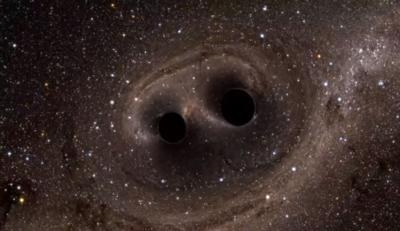NASA Researcher Posits An Alternative Interpretation Of The Relationship
Dark matter is a mysterious substance composing most of the material universe, now widely thought to be some form of massive exotic particle. An intriguing alternative view is that dark matter is made of black holes formed during the first second of our universe's existence, known as primordial black holes. Now a scientist at NASA’s Goddard Space Flight Center in Greenbelt, Maryland, suggests that this interpretation aligns with our knowledge of cosmic infrared and X-ray background glows and may explain the unexpectedly high masses of merging black holes detected last year.

"This study is an effort to bring together a broad set of ideas and observations to test how well they fit, and the fit is surprisingly good," said Alexander Kashlinsky, an astrophysicist at NASA Goddard. "If this is correct, then all galaxies, including our own, are embedded within a vast sphere of black holes each about 30 times the sun's mass."
In 2005, Kashlinsky led a team of astronomers using NASA's Spitzer Space Telescope to explore the background glow of infrared light in one part of the sky. The researchers reported excessive patchiness in the glow and concluded it was likely caused by the aggregate light of the first sources to illuminate the universe more than 13 billion years ago. Follow-up studies confirmed that this cosmic infrared background (CIB) showed similar unexpected structure in other parts of the sky.
In 2013, another study compared how the cosmic X-ray background (CXB) detected by NASA's Chandra X-ray Observatory compared to the CIB in the same area of the sky. The first stars emitted mainly optical and ultraviolet light, which today is stretched into the infrared by the expansion of space, so they should not contribute significantly to the CXB.
Yet the irregular glow of low-energy X-rays in the CXB matched the patchiness of the CIB quite well. The only object we know of that can be sufficiently luminous across this wide an energy range is a black hole. The research team concluded that primordial black holes must have been abundant among the earliest stars, making up at least about one out of every five of the sources contributing to the CIB.
The nature of dark matter remains one of the most important unresolved issues in astrophysics. Scientists currently favor theoretical models that explain dark matter as an exotic massive particle, but so far searches have failed to turn up evidence these hypothetical particles actually exist. NASA is currently investigating this issue as part of its Alpha Magnetic Spectrometer and Fermi Gamma-ray Space Telescope missions.
"These studies are providing increasingly sensitive results, slowly shrinking the box of parameters where dark matter particles can hide," Kashlinsky said. "The failure to find them has led to renewed interest in studying how well primordial black holes -- black holes formed in the universe's first fraction of a second -- could work as dark matter."
Physicists have outlined several ways in which the hot, rapidly expanding universe could produce primordial black holes in the first thousandths of a second after the Big Bang. The older the universe is when these mechanisms take hold, the larger the black holes can be. And because the window for creating them lasts only a tiny fraction of the first second, scientists expect primordial black holes would exhibit a narrow range of masses.

On Sept. 14, gravitational waves produced by a pair of merging black holes 1.3 billion light-years away were captured by the Laser Interferometer Gravitational-Wave Observatory (LIGO) facilities in Hanford, Washington, and Livingston, Louisiana. This event marked the first-ever detection of gravitational waves as well as the first direct detection of black holes. The signal provided LIGO scientists with information about the masses of the individual black holes, which were 29 and 36 times the sun's mass, plus or minus about four solar masses. These values were both unexpectedly large and surprisingly similar.
"Depending on the mechanism at work, primordial black holes could have properties very similar to what LIGO detected," Kashlinsky explained. "If we assume this is the case, that LIGO caught a merger of black holes formed in the early universe, we can look at the consequences this has on our understanding of how the cosmos ultimately evolved."
(Images provided with NASA news release and video)
 ANN's Daily Aero-Term (04.24.24): Runway Lead-in Light System
ANN's Daily Aero-Term (04.24.24): Runway Lead-in Light System ANN's Daily Aero-Linx (04.24.24)
ANN's Daily Aero-Linx (04.24.24) Aero-FAQ: Dave Juwel's Aviation Marketing Stories -- ITBOA BNITBOB
Aero-FAQ: Dave Juwel's Aviation Marketing Stories -- ITBOA BNITBOB Classic Aero-TV: Best Seat in The House -- 'Inside' The AeroShell Aerobatic Team
Classic Aero-TV: Best Seat in The House -- 'Inside' The AeroShell Aerobatic Team Airborne Affordable Flyers 04.18.24: CarbonCub UL, Fisher, Affordable Flyer Expo
Airborne Affordable Flyers 04.18.24: CarbonCub UL, Fisher, Affordable Flyer Expo




